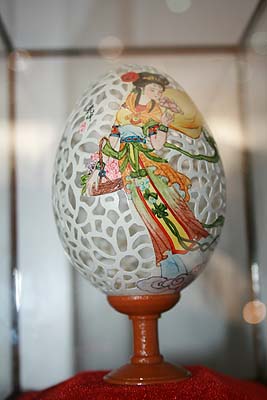|

The eighth annual Shanhua Award Ceremony, the most prestigious event for folk literature and art in China, will be held in Suzhou, east China's Jiangsu Province, on Friday, November 30, 2007.
The award, co-organized by the China Federation of Literary and Art Circles (CFLAC) and the Chinese Folk Literature and Art Society since 1999, aims to improve the quality of Chinese folk literature and arts on the one hand, and stimulate folk artists' creativity on the other hand.
According to organizers, there are two features of this year's activity. One is the choice of location. It is the first time that the award ceremony will be held outside Beijing. This can be seen as a leap forward, in an effort to reach a wider audience. Another feature is the organizing of the week-long folk art exhibition in tandem with a handicraft exhibition, with the intention of protecting traditional art and culture and promoting them among younger generations.
The opening ceremony of two exhibitions, the Top Chinese Folk Handicrafts Exhibition and the Seventh Suzhou Top Folk Handicrafts Exhibition, kicked off on Thursday, a day ahead of the Shanhua award ceremony.
The Erdos Wedding by Lu Yunshan and his student Wang Caixia, a 33m-long, 0.8m-high pokerwork on artificial leather, fascinated thousands at the Top Chinese Folk Handicrafts Exhibition.
"We've produced a pokerwork trilogy based on the Mongols' life in Erdos -- the day of birth, wedding, and a birthday celebration, in that order," Lu told Beijing Review, "It has taken us almost thirteen years to finish this one. I was awarded the golden prize of the Shanhua award previously for my trilogy."
"Personally, it's worth spending eighteen years to finish a once-in-a-lifetime masterpiece," said Lu, who comes from the Mongol ethnic groups in Erdos, Inner Mongolia Autonomous Region. "I was born in Erdos and am familiar with the life there. I'm willing to do something for my hometown. More importantly, ‘art without boundaries' is what I believe in and adhere to. As a result, my student is not a Mongol."
The Seventh Suzhou Top Folk Handicraft Exhibition, the pillar of the city's largest folk festival, presented a thick local flavor in terms of color, appearance and materials. Eggshell carvings, paintings on wood, double-sided embroidery, etc. captivated the audience.
"All the work at the exhibitions represents the highest level of folk handicrafts in China," Luo Yang, head of the Chinese Folk Literature and Art Society told Beijing Review. "I'm sure that the audience will be touched by the power of people's wisdom and the nature of folk arts." | 